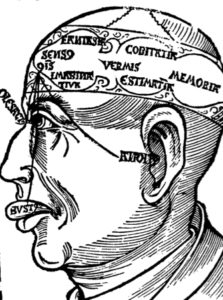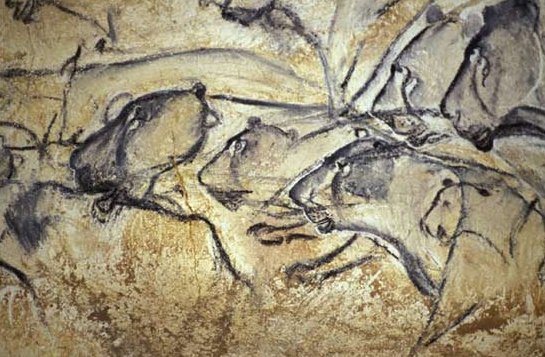With Caleb Carr’s latest novel, The Legend of Broken, released in paperback last month, I thought it might be interesting to take some time away from the Alienist books for the next two blog posts to discuss what was known about psychology during the period in which Broken was set. Coming from a background in psychology, I can attest that almost every history of psychology textbook either ignores or skims over the thousand year period from Rome to the Renaissance with the general argument being that medieval thinking, centered largely in theology, had put an end to scientific enquiry of all kinds, fostered little-to-no interest in matters of philosophy beyond questions directly related to spirituality, and regarded the mentally ill as being possessed by the devil or witchcraft. Although there are certainly elements of truth in these generalisations, to generalise the entire thinking of a people spanning a thousand year time period with such a limited scope does no credit to the scholars who did live during that period. After all, how can medieval theologians such as Saint Barnard and Saint Peter Damien be considered “antiphilosophers” if there were no philosophers during the time period to target?
So, let us take a journey back in time to the year 750 A.D. In doing so, we step into the heart of a period of political and cultural turmoil that would come to be known to history as the Dark Ages, a period generally thought to span the fourth or fifth century A.D. to the eleventh century A.D. On our particular journey, we arrive outside a cave hidden deep in the heart of a forest located at the base of the highest peak of the Harz mountain range in Germany. The sun has not yet risen, the air is still, and inside the cave an old man lies sleeping while his companion, sensing an intruder in their midst, has moved to maintain a silent vigil at the door of their simple dwelling. Looking into the cave past the companion, the glowing embers of a smoldering fire allow us to discern the indistinct shapes of the old man’s most beloved treasures, the items we have come to the cave to find: the collected works of the great minds of antiquity. The large quantity of parchment–some works rolled onto scrolls while others are bound in a rudimentary fashion–rests on a ledge that the old man painstakingly chiseled into one of the cave walls during the years immediately following his exile from the nearby mountaintop kingdom that he once called home; a city known as Broken.
The old man is a scientist, a physician, and above all, a philosopher. He is a rarity in these times, but not altogether unheard of. The old man’s interests span widely, ranging from metallurgy to anatomy to military strategy, but on our journey we are most interested in his knowledge of the mind. Learned though the old man is, the study of the mind as we know it today is foreign to him–indeed, even the term psychology would mean nothing to him, with its predecessor psychologia first coined in 1520–but a fascination with “what animates the bodies and minds of the men and creatures who inhabit [the] world” is certainly not foreign to him. Indeed, looking back at the ledge we see that his collection of works includes volumes by Plato, Plotinus, Aristotle, and Dioscorides, along with Hippocrates, Galen, Praxagoras, Herophilus, and Erasistratus. What did these works by the legendary philosophers and physicians from times gone past allow scholars like the old man to induce about the mind and brain during these ‘Dark Ages’?
To answer these questions we must first understand that the old man’s collected works span two different psychological traditions. The first and most influential forerunner of modern cognitive psychology was the philosophical tradition. This tradition centered on the teachings of Plato and Aristotle, and was concerned with questions relating to the nature of the soul versus the mind, how cognitive functions such as memory operate, and how internal representations of what we perceive can be manipulated through faculties such as imagination. The second tradition that was also influential in modern psychology and psychiatry was the medical tradition, and centered on the teachings of physicians such as Hippocrates and Galen. This tradition was more concerned with understanding how the body and brain functioned in concert with the mind and soul, and was consequently more influential for the treatment of the mentally ill during the Dark Ages than the philosophical tradition had been. Nevertheless, it would be a mistake to view the two traditions as incompatible or separable. Like the old man, learned scholars throughout antiquity and the Middle Ages were generally as widely read as the availability of texts allowed, and ideas arising from one tradition were frequently blended with ideas from other traditions.
With this established, let us now return to our original question of what scholars such as the old man might have known about the functioning of the mind and brain. First, it is important to note that during the Middle Ages human cognition was generally believed to consist of two component parts: universal knowledge that roughly corresponded to semantic information, consciousness, free will, and abstract reasoning about God, and particular knowledge that roughly corresponded to cognitive processes such as sensory perception, mental imagery, memory, and so on. While universal knowledge was believed to be carried out in the mind, a faculty that was assumed not to be tied to the body1, particular knowledge was reasoned to take place within the brain in an extension of Aristotle’s theory that mental imagery, memory, and the faculty to integrate the input from the five sense modalities (known as common sense, not to be confused with the modern connotation of the term) were housed in organs of the body, as well as Galen’s later theory that memory was housed in the brain’s cortex.
 From the fourth to the sixteenth century A.D., the most commonly cited theory put forward to explain how particular knowledge was stored in the brain was the theory of the inner senses. Although the originator of the theory is unknown, multiple different versions of the theory were advanced throughout the Middle Ages, with the earliest versions being put forth by Nemesius in 400 A.D. and Saint Augustine in 426 A.D. suggesting that the theory’s basic tenants were widely known by the onset of the Dark Ages. Within the theory, the brain was proposed to contain three ventricles connected in a linear configuration with sensory nerves attached to the first ventricle. The common sense was theorised to receive the inputs from the sensory nerves in the front half of the first ventricle as a means to sum, compare, and discriminate the information from the five different sense modalities. Mental images formed on the basis of this sensory information (known as imagination) were then presumed to form at the back of the first ventricle. These images, known as forma or species, were then passed to the second ventricle which was proposed to contain a cogitative faculty to allow humans to reorganise the images into new forms (e.g., a golden mountain) along with an estimative faculty to allow meaning to be extracted from the real or imagined images under consideration. Finally, the third ventricle acted as a memory store for any information passed from both the cogitative and estimative faculties of the second ventricle.
From the fourth to the sixteenth century A.D., the most commonly cited theory put forward to explain how particular knowledge was stored in the brain was the theory of the inner senses. Although the originator of the theory is unknown, multiple different versions of the theory were advanced throughout the Middle Ages, with the earliest versions being put forth by Nemesius in 400 A.D. and Saint Augustine in 426 A.D. suggesting that the theory’s basic tenants were widely known by the onset of the Dark Ages. Within the theory, the brain was proposed to contain three ventricles connected in a linear configuration with sensory nerves attached to the first ventricle. The common sense was theorised to receive the inputs from the sensory nerves in the front half of the first ventricle as a means to sum, compare, and discriminate the information from the five different sense modalities. Mental images formed on the basis of this sensory information (known as imagination) were then presumed to form at the back of the first ventricle. These images, known as forma or species, were then passed to the second ventricle which was proposed to contain a cogitative faculty to allow humans to reorganise the images into new forms (e.g., a golden mountain) along with an estimative faculty to allow meaning to be extracted from the real or imagined images under consideration. Finally, the third ventricle acted as a memory store for any information passed from both the cogitative and estimative faculties of the second ventricle.
It is clear that several elements from the theory of the inner senses were taken directly taken from earlier ideas put forward in both the philosophical and medical traditions of antiquity. The mental imagery component of the theory, for example, appears to have been directly taken from one of the most widely known philosophical ideas about the mind from Ancient Greece, the wax tablet metaphor. First proposed by Plato in his Theaetetus and revisited by Aristotle in his De Anima (On the Soul), representations of sensory stimuli were believed to be perceived in a manner similar to the imprints objects leave on blocks of wax. In an attempt to better explain the concept, let us briefly turn to one of Aristotle’s examples. Imagine, Aristotle proposed, a signet-ring (corresponding to external/sensory stimuli) being pressed into wax. In this example, the signet leaves a lasting impression in the wax (corresponding to a metaphorical internal representation) without the necessity of the ring’s material properties also being stored. That is, whether the ring is bronze or gold makes no difference to the impression the ring leaves behind. In this way, forma or species could be thought to retain actual spatial properties of sensory stimuli rather than simply being abstract representations, even though they were not thought to represent all of the stimuli’s properties.2
In the medical tradition, the clearest connection to the theory of the inner senses can be found in Galen’s theory of animal spirits. Galen, a prominent Roman anatomist, conducted anatomical investigations that led him to propose that food spirits were extracted in the liver and spread throughout the body after being refined in the heart. The most refined of these spirits, thought to originate in the rete mirabile (a system of blood vessels found in the necks of certain mammal species although not, as Galen had mistakenly believed, in humans), were referred to as animal spirits. Galen proposed that animal spirits fill the ventricles of the brain along with the sensory and motor nerves, thereby allowing the sense modalities and muscles to be connected to the brain. It is noteworthy that unlike the three-part ventricular system described in the theory of the inner senses, Galen described the physical arrangement of the cerebral ventricles relatively accurately, although he did err both in his proposal that the human brain contained a rete mirabile and in his belief that sensory nerves attach directly to the anterior ventricles. As a result, it has been proposed that Galen’s teachings were adapted during the Middle Ages to fit the theory of the inner senses rather than the theory being adapted to fit the actual cerebral ventricular system. Nonetheless, Avicenna’s twelfth century version of the theory of the inner senses even extended the theory to incorporate animal spirits as the fluid contained within the ventricles, highlighting just how important Galen’s ideas continued to be for medieval theories about the brain and cognitive functioning for the entirety of the Middle Ages.
Theorising that certain cognitive processes such as imagination and memory were housed in the brain rather than forming part of the mind/soul did create philosophical difficulties for theologians during the Middle Ages given the questions such a theory raised about how immortal souls would be able to remember or imagine after death if those processes were tied to a mortal body. Despite these difficulties, the theory of the inner senses was ultimately deemed necessary in order to account for animal behaviour (animals were not assumed to possess immortal souls so their capacities for memory and sensory processing necessarily required a physical origin) as well as to account for mental illness and loss of cognitive functioning due to injury or illness. In consequence of this, we will return to the theory of the inner senses later in the week to discuss how the theory allowed physicians such as the old man to account for mental illness, and how functions such as dreaming and hallucination were interpreted during the Dark Ages.
Footnotes
1. You may note that the idea of the mind being separate to the body gives this faculty similar properties to those we think of as being assigned to the ‘soul’ in modern Christian theology, and indeed the concepts of mind and soul were subject to debate for much of antiquity and the Middle Ages, with Plotinus’s theory of a tripartite spiritual world existing above the physical world taking hold from approximately the third century A.D. onwards while Aristotle’s ideas about differentiated types of souls possessed by plants, animals, and humans received a revival in the later Middle Ages. As this topic is ultimately too complex to explain here, I have treated the mind and soul in a relatively interchangeable way throughout my discussions as my focus is on medieval concepts of cognitive processes and the medical traditions of psychology rather than providing an analysis of how the mind/soul was perceived during the Middle Ages.
2. Saint Augustine also argued for the internal storage and later retrieval of forma or species on the basis of the afterimage phenomenon, the observation that upon viewing a bright light, a negative afterimage of the light can be viewed “the eye of the mind” when we close our eyes, with the afterimage roughly corresponding to the same shape and size as the original light source. Augustine went on to argue that while we are not aware of afterimages in normal daily activity, such internal representations of everything we perceive are nonetheless always present in our senses.
Sources
- Henley, T. B., & Thorne, B. M. (2005). The lost millennium: Psychology during the middle ages. The Psychological Record, 55(1), 103-113.
- Hunt, M. (2007). The Story of Psychology. United States: Anchor Books.
- Kemp, S. (1998). Medieval theories of mental representation. History of Psychology, 1(4), 275-288.
- Kemp, S. (2000). Psychology: The middle ages. In A. E. Kazdin (Ed.), Encyclopedia of Psychology (Vol. 6, pp. 382-385). Washington D.C., United States: American Psychological Association.
- Kemp, S. (1993). The medieval theory of the inner senses. American Journal of Psychology, 106(4), 559-576.


